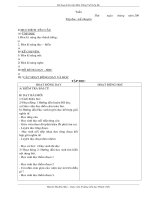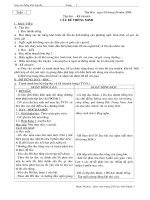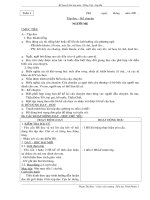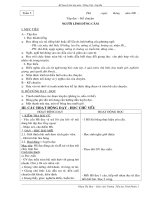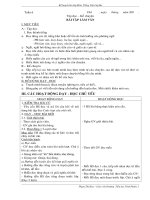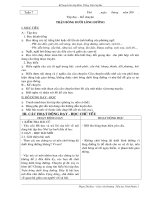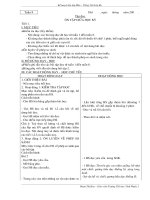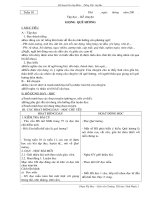Giáo án môn Tiếng Anh_Lớp 5_Tuần 21_GV: Lê Thị Lan Anh
Bạn đang xem bản rút gọn của tài liệu. Xem và tải ngay bản đầy đủ của tài liệu tại đây (77.19 KB, 6 trang )
<span class='text_page_counter'>(1)</span><div class='page_container' data-page=1>
<b>WEEK 21:</b>
Date of planning : 21/01/2018
Date of teaching : 22 –23/01/2018
Period: 81
<b>UNIT 12: DON’T RIDE YOUR BIKE TOO FAST!</b>
<b>Lesson 3: Part 1-2-3</b>
<b>I. </b>
<b> O bjectives</b>
By the end of the lesson, students will be able to identify the intonation of a
sentences and pronounce them correctly.
-develop listening and speaking skills.
<b>II. Language focus</b>
- Phonics:
Don’t play with the knife! – OK, I won’t.
Don’t play with the matches. – OK, I won’t.
Why should I play with the knife? – Because you may cut yourself.
Why should I play with the stove? – Because you may get a burn.
<b>II</b>
<b> I . Resources </b>
- Teacher’s aids: student’s and teacher’s book, CD, cassette.
- Students’ aids: books, notebooks, workbooks.
<b>IV. Teaching Procedure</b>
<b>Steps/Activities</b> <b>Work</b>
<b>arrangement</b>
<b>1. Warm up</b>
- Have ss to give and respond to advice on common health
proplems.
<b>2. New lesson</b>
<b>Activity 1: Listen and repeat</b>
- Tell ss they are going to practice saying the stress in
sentences, and pronounce correctly some sentences
- Do choral and individual repetition.
- Play the recording for ss to listen and say along.
<b>Activity 2: Listen and circle a or b. Then say the sentences </b>
<b>aloud</b>
-Tell ss they are going to listen and circle the correct answers.
Give ss a few seconds to read the text.
- Play the recording twice for ss to listen and do the tasks.
- Have ss to swap and check their answer before checking as
class.Write the correct answers on the board for ss to copy
Pairs
Whole class
Individual
Pairs/Groups
</div>
<span class='text_page_counter'>(2)</span><div class='page_container' data-page=2>
down into their notebooks.
- Call some ss to read aloud the sentences.
<b>Activity 3: Let’s chant</b>
- Tell ss they are going to practice saying the “Why shouldn’t
he do that?”chant. Read the chant and check comprehension.
- Play the recording a few times for ss to do choral and
individual repetition.
- Show ss how to chant and do the action. Call on 2 groups to
demonstrate. The have ss to work in groups.
- Call on two groups to chant and do the action. The rest of the
class claps along the rhythm of the chant.
<b> 3. Home - link</b>
- Practice reciting the chant at home.
Whole class
Pairs/Groups
T-WC
Date of planning : 21/01/2018
Date of teaching : 23 –24/01/2018
Period: 82
<b>UNIT 12: DON’T RIDE YOUR BIKE TOO FAST!</b>
<b>Lesson 3: Part 4-5-6</b>
<b>I. </b>
<b> O bjectives</b>
By the end of the lesson, students will be able to :- read for information, write
about accident prevention.
-develop reading and writing skills.
<b>II. Language focus</b>
- Vocabulary: type, tip, safe
- Sentence partners: review.
<b>II</b>
<b> I . Resources </b>
- Teacher’s aids: student’s and teacher’s book, CD, cassette.
- Students’ aids: books, notebooks, workbooks.
<b>IV. Teaching Procedure:</b>
<b>Steps/Activities</b> <b>Work</b>
<b>arrangement</b>
<b>1. Warm up:</b>
- Have ss to recite the chant “Why shouldn’t he do that?”
<b>2. New lesson:</b>
<b>Activity 1: Read and do the tasks.</b>
- Tell ss they are going to read the texts and circle the best
T - WC
</div>
<span class='text_page_counter'>(3)</span><div class='page_container' data-page=3>
title.
- Has sts tick T/F .
- Give a few seconds for ss to read the texts. Check
comprehension and give feedback.
- Have ss to do the task in pairs.
- Go around to offer help, if necessary.
- Get ss to swap and check their answers before checking as a
class. Write the correct answer on the board for ss to copy
down into their notebooks.
- Call individual ss to ask and answer the question.
<b>Activity 2: Write what may happen.</b>
- Tell ss that they are going to write about what may happen
- Have ss to discuss about the questions.
- Set the time for ss to do the task.
- Monitor the activity, and offer help if necessary.
- Get ss to swap their writing before inviting some ss to read
aloud their writing and give feedback.
<b>Activity 3: Project</b>
-Tell ss they are going to a poster about home accidents and
how to avoid them, after that show the pictures to their group,
then the class, and describe their pictures. Check ss’
understanding.
- Give ss time to do the project in class. Get ss work in groups.
- Call several individuals to report their result.
<b>Activity 4: Colour the stars</b>
<b>- </b>Tell the ss that they are going to read the statements, and
colour the stars according to their ability. Check understanding.
- Set the time for ss to do the task.
- Give feedback.
<b>3. Home – link.</b>
- Practice reciting the chant “Why shouldn’t he do that?”at
home.
Individual
Pairs/Groups
Whole class
Individual
Pairs/Groups
Whole class
Individual
Pairs/Groups
Individual
T – WC
Date of planning : 21/01/2018
Date of teaching : 24 –25/01/2018
Period: 83
</div>
<span class='text_page_counter'>(4)</span><div class='page_container' data-page=4>
<b>Lesson 1: Part 1-2-3</b>
<b>I. </b>
<b> O bjectives</b>
By the end of the lesson, students will be able to: - know more new words.
-ask and answer about what someone does in his/ her free time.
- develop listening and speaking skills.
<b>II. Language focus</b>
- Vocabulary: free time, karare,…
- Sentence partners: What do you do in your free time? – I _____.
<b>II</b>
<b> I . Resources </b>
- Teacher’s aids: student’s and teacher’s book, CD, cassette.
- Students’ aids: books, notebooks, workbooks.
<b>IV. Teaching Procedure</b>
<b>Steps/Activities</b> <b>Work</b>
<b>arrangement</b>
<b>1. Warm up</b>
- Introduce new lesson.
<b>2. New lesson</b>
<b>Activity 1: Look, listen and repeat</b>
- Have ss to look at the picture, identify the characters, and
what they are doing.
- Set up the situation of the conversation.
-Have Ss to listen to the recording as they read each line.
- Elicit the new words and new sentences from ss.
- Play the recording again for ss to repeat twice.
- Divide the class into three groups to play roles.
- Check some groups.
- Play the recording again for the whole class to repeat each line
in the speech bubbles to reinforce their pronunciation.
<b>Activity 2: Point and say</b>
- Tell ss that they are going to practice asking and answering
about what someone does in his/ her free time.
- Teach new words: free time, karare
- Teach new sentence patterns
What do you do in your free time? – I _____.
- Have ss to repeat the question and answer a few times.
- Call one student to read the actions under picture a. Make
question and have one student answer. Have choral repetition.
Then have some pairs to repeat.
T-WC
Whole class
Individual
Pairs/Groups
</div>
<span class='text_page_counter'>(5)</span><div class='page_container' data-page=5>
- Repeat the procedure with the rest pictures.
- Get ss to work in pairs. Monitor the activity and offer.
- Call on some pairs to perform their tasks. Others give
comments.
<b>Activity 3: Let’s talk</b>
- Tell ss they are going to practice more with their friends.
- Ask the first question and have one student answer. Write
sentence on the board. Get ss repeat the sentences a few times.
Call some pairs to repeat.
- Get ss work in pairs. Monitor the activity and offer help.
- Call some pairs to act out. Correct pronunciation.
<b>3. Home - link</b>
- Practice asking and answering about what someone does in
his/ her free time at home.
Whole class
Pairs
T-WC
Date of planning : 21/01/2018
Date of teaching : 25 –26/01/2018
Period: 84
<b>UNIT 13: WHAT DO YOU DO IN YOUR FREE TIME?</b>
<b>Lesson 1: Part 4-5-6</b>
<b>I. </b>
<b> O bjectives : </b>
By the end of the lesson, students will be able to:- listen and read for information
about what someone does in his/ her free time.
-develop listening and reading skills.
<b>II. Language focus : </b>
- Sentence partners: review
<b>II</b>
<b> I . Resources </b>
- Teacher’s aids: student’s and teacher’s book, CD, cassette.
- Students’ aids: books, notebooks, workbooks.
<b>IV. Teaching Procedure:</b>
<b>Steps/Activities</b> <b>Work</b>
<b>arrangement</b>
<b>1. Warm up:</b>
- Have ss to ask and answer questions about what someone does
in his/ her free time<b>.</b>
<b>2. New lesson:</b>
</div>
<span class='text_page_counter'>(6)</span><div class='page_container' data-page=6>
<b>Activity 1: Listen and tick</b>
- Tell the class that they are going to listen and tick the correct
pictures.
- Draw ss’ attention to the pictures. Elicit the names of of
characters and the events. Have ss to repeat them once or twice.
- Play the recording twice for ss to listen, do the task and check
their answers.
- Get ss to swap and check their answer before checking as a
class.Write the correct answers on the board for ss to copy down
into their notebooks.
- Ask some questions to check ss’ comprehension.
<b>Activity 2 : Read and complete</b>
- Tell ss they are going to read and complete the dialogue. Have
ss to read the texts.
- Pre – teach vocablary
- Have ss to do the task individually.
- Go around and offer help, if necessary.
- Get ss to swap and check their answers before checking as a
class. Write the correct answer on the board for ss to copy down
into their notebooks.
- Call pairs to ask and answer the question.
<b>Activity 3: Let’s play</b>
- Tell ss they are going to play a matching game.
- Show ss how to play game. Check ss’ understanding.
- Have ss to play game in groups.
- Check ss’ result.
- Practice asking and answering questions about what someone
does in his/ her free time.
<b>3. Home – link.</b>
- Practise more
Whole class
Individual
Pairs/Groups
Whole class
Individual
Pairs/Groups
Whole class
Individual
Pairs/Groups
</div>
<!--links-->
